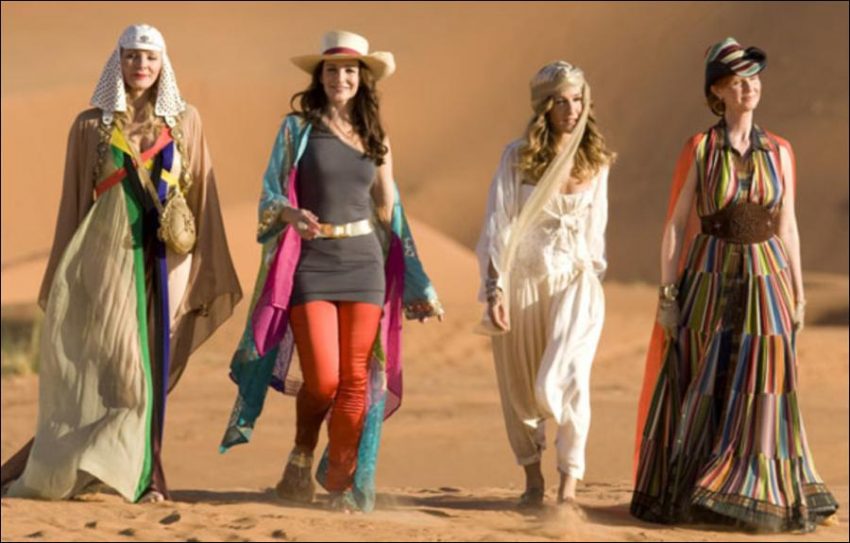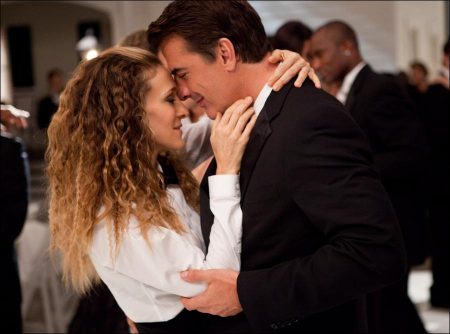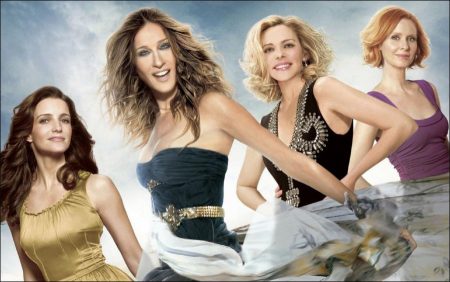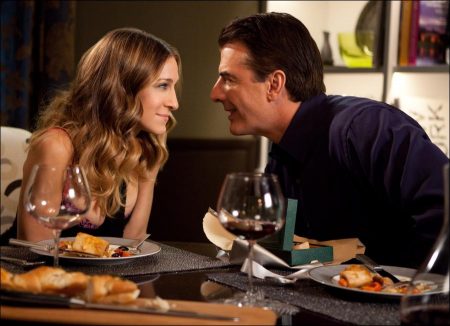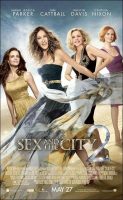Taglines: Carrie on.
Carrie, Samantha, Charlotte and Miranda take another bite out of the Big Apple in the sequel to the 2008 summer blockbuster. It has been two years since Carrie’s marriage to Mr. Big. She has continued to write but now as a married person. Carrie and her friend all feel boxed in and decide to take a trip to the Middle East just to have a get away with the girls.
The fun, the friendship, the fashion: “Sex and the City 2” brings it all back and more as Carrie (Sarah Jessica Parker), Samantha (Kim Cattrall), Charlotte (Kristin Davis) and Miranda (Cynthia Nixon) take another bite out of The Big Apple—and beyond—carrying on with their busy lives and loves in a sequel that truly sparkles.
What happens after you say “I do?” Life is everything the ladies ever wished it to be, but it wouldn’t be “Sex and the City” if life didn’t hold a few more surprises…this time in the form of a glamorous, sun-drenched adventure that whisks the women away from New York to one of the most luxurious, exotic and vivid places on earth, where there’s something mysterious around every corner. It’s an escape that comes exactly at the right moment for the four friends, who are finding themselves in—and fighting against—the traditional roles of marriage, motherhood and more.
Sex and the City 2 is an American romantic comedy film co-written, produced and directed by Michael Patrick King. It is the sequel to the 2008 film Sex and the City, which is based on the HBO TV series of the same name.
The film was released in cinemas on May 27, 2010, in the United States and May 28, 2010, in the United Kingdom. The film stars Sarah Jessica Parker, Kim Cattrall, Kristin Davis, Cynthia Nixon and Chris Noth, who reprised their roles from the previous film and television series. It also features cameos from Liza Minnelli, Miley Cyrus, Tim Gunn, Ron White, Omid Djalili and Penélope Cruz, as well as Broadway actors, Norm Lewis, Kelli O’Hara, and Ryan Silverman. It received negative reviews from critics, but was a commercial success.
About the Production
Carrie “I arrived on this island at exactly 3:30 PM on Tuesday, June 11, 1986. It seems like only yesterday.”
Twelve years, six seasons and one hugely successful feature film. Since its inception, “Sex and the City” has grown into an international phenomenon, with audiences around the world feeling so close to Carrie, Samantha, Charlotte and Miranda that they practically consider them more like personal friends than fictional characters.
“When the first movie opened,” recalls writer/producer/director Michael Patrick King, “I would see lines of women at the theaters all dressed up as if they were going to a party, not just a movie. It felt to me like they were excited to celebrate this special time with their girlfriends—both the ones in the seats and on the screen. So when I thought about the sequel, I knew I wanted it to be the continuation of the party. I wanted the movie to be the party.”
Sarah Jessica Parker, who not only reprises her role as Carrie Bradshaw but is once again a producer on the film, says, “It’s very moving and truly thrilling to be part of something that people have connected with and have strong feelings about, something that they’ve welcomed into their homes every week and then gone to the theatre to watch. So we gave a lot of thought as to how we’d take them into the next phase, two years down the road.”
Despite the resolution of the first film’s major plotlines, there remains plenty to say about these four women and the loves in their lives. Producer John Melfi offers, “It’s exciting to go to the next chapter, to see what happens next.”
As King began to reflect on how far the characters have come, and to explore where they might be after we last saw them two years ago, a theme began to emerge: tradition.
Though he didn’t want “Sex and the City 2” to be a conventional comedy, the various forms and facets of tradition played right into King’s hands, and he turned the genre on its ear. “These four women are not traditional and never have been. Miranda had a baby out of wedlock, then got married late, and she’s the alpha spouse. Charlotte converted to Judaism, adopted an Asian daughter and had another daughter. Samantha has tried relationships and decided she’s always going to be single. And Carrie is somebody who has tried everything she can to make her relationship work with Big and still be a self-employed writer.”
In fact, Parker notes, “Carrie, who at one point thought she might not be the marrying type, is finally married to the love of her life, the man she spent most of her adult life pursuing.” She further adds that Carrie is not alone in reaching a crossroads in her life. “All the women, at this point in their lives, appear to be content with having what they thought they wanted. But, as Michael Patrick so cleverly does in his writing, there’s nuance and layers and complications under the surface.”
“At the start of this movie, each of these four characters has found herself beginning to feel boxed in by one of those ‘female’ roles,” King says. “Carrie Bradshaw, the eternal single girl, now finds herself struggling with the title of wife. How does the title of ‘Mrs.’ affect a woman whose identity, not to mention career path as a writer, has been tied to the idea of being single? Miranda, a partner at a prestigious New York Law firm, has discovered that despite all her years to prove otherwise, there can be a glass ceiling for women who work. Charlotte, who always dreamed of being the perfect mother to a loving family, now has the loving family and is discovering just how far out of her reach being the ‘perfect’ mother really is. The outrageous and outspoken Samantha takes on the taboo of menopause and aging by fighting the idea that when a woman goes through the ‘change,’ she should have to change.”
Still playing with their theme, the filmmakers found a way to amp up the level of fantasy in this film by taking the four friends on a vacation to one of today’s most exotic, sought-after locations in the world, a place at once completely modern and entirely traditional, the United Arab Emirates.
Carrie “Gotta hand it to you, Samantha – not blowing us off for a guy…very classy.”
Samantha “Well, we made a deal a while ago. Men, babies – doesn’t matter. We’re soulmates. The Fabulous Femmes…
In bringing “Sex and the City,” in any incarnation, to the screen, King, Parker and the rest of the filmmakers and cast felt a great sense of responsibility to their characters, especially Carrie, Samantha, Charlotte and Miranda, because each of the women is reflected somewhere in the audience. Therefore, in “Sex and the City 2,” even though they vacate their daily lives and take an exhilarating romp in a stunning locale, the women continue to face very human, true-to-life concerns, as voiced by the ever-questioning chronicler, Carrie.
“Carrie is truly the heart and soul of it all,” says King. “Even when the story focuses on the other women, we hear and see it from Carrie’s perspective to some degree.”
When we first glimpse Carrie and Big in their home together, Carrie Bradshaw—now also known as Mrs. John Preston—is feeling a bit unsettled in her settled, married life, wondering “what happens after you say ‘I do.’” And because Carrie is also a writer, she has even gone so far as to express her feelings about the idea of marriage in her new book, I Do, Do I?, a collection of comic essays in which she lampoons the idea of traditional wedding vows.
“Carrie has spent her career writing about being single, and for the first time she’s writing about a different topic, being married,” Parker observes. “The truth is, she doesn’t know a lot about it yet. But she’s learned that there’s a difference between having a wedding and being married. She’s been married for a very short time and she’s not quite wearing it as comfortably as she wants to.”
“The exciting thing for me when I was writing the Carrie and Mr. Big storyline for this film was to try to figure out what the concept of ‘happily ever after’ might mean to them today, after their passionate, dramatic and mostly turbulent courtship of the past 10 years,” says King. “In the first movie, I really wanted people to believe that Mr. Big finally understood the jewel that he had almost lost by jilting Carrie at the altar, so the end of that movie was deeply romantic, a much-earned ‘happy ending’ for this well-deserving couple. And here they are now, two years later, about to discover what the ‘home-sweet-home’ of it all means. She’s spent two years carefully decorating their new apartment, making their house a home, and now she’s made that married bed and she has to lie in it. And for an ‘out-on-the-town kinda girl’ like Carrie, it’s a ‘Big’ change. Pun intended.’”
Parker adds, “Carrie likes to go out, she likes to live the city life, looking, watching, participating. One of the many things she’s secretly struggling with is the idea of staying in, of these shackles she has figuratively projected onto herself. She’s able to intellectualize it, but emotionally, she’s not actually where she would like to be in the marriage. She wants to be able to say she feels good about the expectations she has had of her partner and herself. So for Carrie, it becomes a story about ‘Yes, I had a wedding, but am I married? Am I married?’”
Miranda Hobbes, having gotten past Steve’s infidelity in the last film, finds herself finally comfortable and secure at home. It’s her job that’s causing her grief. She’s grown increasingly frustrated at work, where her obvious talents are being thwarted by her arrogant and clearly chauvinistic boss.
“Miranda has always defined herself as a career person,” says Cynthia Nixon. “Men might come and go; maybe she would be a mother, maybe she wouldn’t, but she was a lawyer. Now she’s made partner in a great law firm, she has a terrific salary, but she has a new boss who can’t stand the sight or sound of her. We all have our breaking point, and Miranda is reaching hers. To all of a sudden be set adrift and to try to figure out, ‘If I’m not a lawyer, who am I? What else is left of me?’ That would be a big deal for anybody, but particularly so for someone who has defined herself through her career for her entire adult life.”
Miranda’s work-life isn’t the only thing about her that’s changing. “I think the most exciting thing about returning to the character is the way Michael Patrick always keeps her evolving,” Nixon continues. “If you look at who she was when we met her, she was bitter and suspicious and cynical, quick to anger and defensive. She had a lot of trouble with men. Now, although her career is still very important to her, she is a fairly happy wife and mother. And in this film, she is the cheerleader among the four women; she’s the one taking emotional care of the other three. It’s a mark of how much she has grown.”
“An intriguing subliminal thought about the Miranda storyline to me,” says King, “is that in the first half of the movie she is tied to her job, her face always buried in her BlackBerry. But once she makes the decision to put down the BlackBerry, she sees the world.”
Also a wife and mother, Charlotte York-Goldenblatt has spent the last two years in the midst of her growing family, and now finds herself in the middle of the “terrible twos” with her daughter Rose. “Things are not going smoothly for Charlotte,” admits Kristin Davis.
“She still really wants everything to be perfect, and it’s hard for her to accept the fact that it’s not…and that she’s not perfect either. It’s been her ongoing struggle throughout the life of the character. It’s a continuous battle as to how overachieving she can be and how many surprises have to be thrown her way before she can actually let go a little bit and stop this pursuit of perfection. And now baby Rose is the biggest challenge of all, even if Charlotte can’t admit it.”
Another thing Charlotte doesn’t see is how attractive her new nanny, Erin, played by British actress Alice Eve, is. But, thanks to observations from Samantha, she wonders whether Harry may stray in that direction. “Charlotte begins obsessing over how gorgeous her nanny is, something she originally didn’t notice because Erin is so wonderful with Rose and Charlotte so desperately needs her,” Davis says.
“Charlotte’s storyline has a lot to do with trust,” says King. “Because of the exhaustion that can come with the demands of motherhood, she is too worn down to trust her own instincts about the choice of her nanny, her husband’s fidelity and even her own abilities as a mother. This little getaway with the girls gives her the luxury of some much needed sleep and she regains her ability to trust her instincts again.”
While Charlotte is mired down with the challenges of parenthood, a single Samantha Jones, back in New York and back on the prowl, once again represents the epitome of freedom. “Samantha is back in her seat of power, back in her town with her girlfriends—her family—around her,” Kim Cattrall says.
The most outgoing of the foursome, Samantha is a smart hedonist who lives life on her own terms. However, this time around, life is throwing the sexy blonde a few curveballs as she is forced to deal with the idea of aging and what locking horns with the first symptoms of menopause means for her liberated lifestyle. Cattrall looked forward to approaching this fact of life from a comedic point of view. “For me, incorporating comedy into a menopausal storyline was incredibly gratifying, because you hear so many negative stories about what women have to go through at that time of their lives,” she comments. “I feel we’ve taken that subject and mined gold out of it by making it human and funny and accessible. Samantha has a tremendous lust for life and she’s a powerhouse about her sexuality; she enjoys it and integrates it into every aspect of her life. So when that part of her is challenged, she fights back with all she’s got.”
“One of the successes of the ‘Sex and The City’ brand,” says King, “is its ability to evolve. The idea of Samantha entering menopause never frightened me for a second because I knew that if anyone could play an outrageous menopause story, it’s Kim Catrall, and because some of the audience is experiencing what Samantha is going through, and she is having the struggle and the victory for them.”
The filmmaker continues, “These four actresses embody something very special, something everyone relates to,” says King. “Whether people feel that they are like Carrie, or Miranda, or they have a friend who is like Charlotte or Samantha, the audience has an investment in these actresses and their characters, and in the emotional journeys they take.”
Carrie “You knew when you married me I was more Coco Chanel than coq au vin.” The Loves of Their Lives…
Accompanying the women on many of these journeys are the various men who’ve come in and out of their lives—after all, what is “Sex and the City” without, well, sex. And Carrie’s writing has depended equally upon the women and men in her life to keep it both racy and relevant. However, no man has had a bigger impact on Carrie than her on-again, off-again boyfriend, friend, lover and, at long last, husband…Mr. Big. Or, as we now know him, John James Preston. When we last saw him, Big was finally able to say “I do,” proving to Carrie that to him she was, indeed, the one.
Now, approaching their second anniversary, the couple is still trying to agree on their own unique definition of marriage. “This movie’s a wonderful example of where it’s possible to go, because a relationship doesn’t end with the wedding, or the party and laughs afterward,” Chris Noth comments. “There is the next day, the next series of moments between people, the next series of challenges. You have a life together and all the ups and downs of that, and that’s what we deal with in this film. Once you get what you think you’ve wanted for so long, what happens then? There’s a whole new set of questions. It’s always a work in progress.”
“Big and Carrie are that New York couple who go to the ballet and to a great dinner and then have champagne on top of a skyscraper, looking out at the Manhattan landscape, and Carrie loves that about them,” says Parker. “But they’re celebrating their anniversary at home, and he’s very romantic in the way that Big can be, and she loves that, too. Then what should have been a romantic exchange of gifts suddenly makes her wonder if he really knows her at all.”
On the opposite end of the spectrum, Miranda and Steve’s marriage, having come through the turmoil of his one-time infidelity, couldn’t be on firmer ground. “Miranda and Steve are very real, very honest with each other,” David Eigenberg says. “They’re down to brass tacks; they understand that you have to finesse the relationship a little and they are supportive of one another, but they don’t manipulate each other. They just say what they need and they’ve learned how to compromise. It’s a very real relationship.”
“Steve Brady was created specifically to soften Miranda who, at the time, was really sarcastic and really brittle…and really alone,” King offers. “He was an antidote to that because he is a regular guy, and over the years they have, I think, become the most relatable couple.”
While Charlotte and Harry also have a very solid marriage, for the first time, Charlotte begins to have doubts about her loyal husband. Evan Handler explains, “Charlotte has hired a wonderful young Irish woman to help take care of their children. This woman also happens to be extremely gorgeous and to have never worn a bra in her life. This causes Samantha to question why Charlotte would bring such temptation into their home, leading to suspicions that had never occurred to Charlotte before. The movie poses the question of whether Harry has become untrustworthy, or whether Charlotte has grown paranoid.”
“Charlotte’s journey was always to find a tall, dark, handsome, rich WASP; her evolution as a character was that she saw past what she had imagined and was able to feel what real people feel, and fall in love with Harry Goldenblatt,” says King. “She never had to question his feelings for her, and even now the impulse to do so isn’t coming from him, but from an equally influential source: Samantha, one of her best friends.”
Not to be outdone by the ladies, Stanford and Anthony—Carrie and Charlotte’s best gay friends, respectively—have each found the love of their life: Anthony and Stanford, respectively. And though Carrie may have ultimately opted out of the big wedding, nothing can compare to this movie’s black-tie gala nuptials—complete with swans, an all-male chorus and none other than Liza Minnelli herself officiating—all arranged by Stanford, not his wedding planner fiancé, Anthony.
“I’ve been on a lot of movie sets, but I had never seen anything like this,” Willie Garson declares. “It was reminiscent of a Busby Berkeley musical of the `30’s and `40s, with hundreds of extras and an orchestra and two camera cranes. It was probably the biggest thing I’ll ever be part of.”
Mario Cantone turned the occasion into a true family affair. “I got my sisters, Marion and Camille, to walk me down the aisle, so it was actually very emotional,” he relates. “And for my character to have this great sequence at the beginning of the movie was really thrilling and magical, something I’ll never forget.”
“Stanford Blatch and Anthony Marantino are polar opposites,” King says. “Anthony’s an opinionated, bossy, prickly, hilarious man, and Stanford’s sweet, vulnerable fussy and emotional; but, as they say, opposites attract, so really they’re just like any other couple. And now they’re having this over-the-top wedding, and Anthony is uncomfortable with the tradition of it all, so he fights off the wedding emotions…until the vows.”
One character who has vowed never to be tied down again is Samantha…though she’s not opposed to possibly being tied up by former boyfriend Smith Jerrod. In New York for the premiere of his newest film, Smith invites his former flame and her friends to the big event. For the splashy red carpet scene, the filmmakers were able to bring in some exciting guest stars in cameo roles, including fashion guru Tim Gunn and teen fashionista Miley Cyrus, who shares an unexpected paparazzi-fueled moment with Samantha.
Of course, getting such A-listers to New York for the filming took some careful juggling of schedules. “Miley was in the middle of a concert tour, and flew in for the night from San Francisco with only six or seven hours to work before she had to get back on a plane,” Melfi recalls.
Sex and the City 2 (2010)
Directed: Michael Patrick King
Starring by: Sarah Jessica Parker, Kim Cattrall, Kristin Davis, Cynthia Nixon, Chris Noth, David Eigenberg, Evan Handler, Parker Fong, Alexandra Fong, Mario Cantone, Liza Minnelli, Noah Mills
Screenplay by: Michael Patrick King
Production Design by: Jeremy Conway
Cinematography by: John Thomas
Film Editing by: Michael Berenbaum
Costume Design by: Patricia Field, Jacqueline Oknaian
Set Decoration by: Lydia Marks, Lee Sandales
Art Direction by: Miguel López-Castillo, Marco Trentini
Music by: Aaron Zigman
MPAA Rating: R for some strong sexual content and language.
Studio: New Line Cinema
Release Date: May 28, 2010
